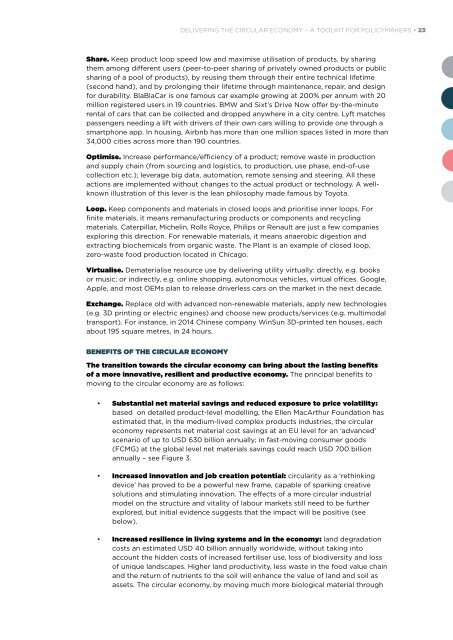DELIVERING THE CIRCULAR ECONOMY A TOOLKIT FOR POLICYMAKERS
20150924_Policymakers-Toolkit_Active-links
20150924_Policymakers-Toolkit_Active-links
You also want an ePaper? Increase the reach of your titles
YUMPU automatically turns print PDFs into web optimized ePapers that Google loves.
<strong>DELIVERING</strong> <strong>THE</strong> <strong>CIRCULAR</strong> <strong>ECONOMY</strong> – A <strong>TOOLKIT</strong> <strong>FOR</strong> <strong>POLICYMAKERS</strong> • 23<br />
Share. Keep product loop speed low and maximise utilisation of products, by sharing<br />
them among different users (peer-to-peer sharing of privately owned products or public<br />
sharing of a pool of products), by reusing them through their entire technical lifetime<br />
(second hand), and by prolonging their lifetime through maintenance, repair, and design<br />
for durability. BlaBlaCar is one famous car example growing at 200% per annum with 20<br />
million registered users in 19 countries. BMW and Sixt’s Drive Now offer by-the-minute<br />
rental of cars that can be collected and dropped anywhere in a city centre. Lyft matches<br />
passengers needing a lift with drivers of their own cars willing to provide one through a<br />
smartphone app. In housing, Airbnb has more than one million spaces listed in more than<br />
34,000 cities across more than 190 countries.<br />
Optimise. Increase performance/efficiency of a product; remove waste in production<br />
and supply chain (from sourcing and logistics, to production, use phase, end-of-use<br />
collection etc.); leverage big data, automation, remote sensing and steering. All these<br />
actions are implemented without changes to the actual product or technology. A wellknown<br />
illustration of this lever is the lean philosophy made famous by Toyota.<br />
Loop. Keep components and materials in closed loops and prioritise inner loops. For<br />
finite materials, it means remanufacturing products or components and recycling<br />
materials. Caterpillar, Michelin, Rolls Royce, Philips or Renault are just a few companies<br />
exploring this direction. For renewable materials, it means anaerobic digestion and<br />
extracting biochemicals from organic waste. The Plant is an example of closed loop,<br />
zero-waste food production located in Chicago.<br />
Virtualise. Dematerialise resource use by delivering utility virtually: directly, e.g. books<br />
or music; or indirectly, e.g. online shopping, autonomous vehicles, virtual offices. Google,<br />
Apple, and most OEMs plan to release driverless cars on the market in the next decade.<br />
Exchange. Replace old with advanced non-renewable materials, apply new technologies<br />
(e.g. 3D printing or electric engines) and choose new products/services (e.g. multimodal<br />
transport). For instance, in 2014 Chinese company WinSun 3D-printed ten houses, each<br />
about 195 square metres, in 24 hours.<br />
BENEFITS OF <strong>THE</strong> <strong>CIRCULAR</strong> <strong>ECONOMY</strong><br />
The transition towards the circular economy can bring about the lasting benefits<br />
of a more innovative, resilient and productive economy. The principal benefits to<br />
moving to the circular economy are as follows:<br />
• Substantial net material savings and reduced exposure to price volatility:<br />
based on detailed product-level modelling, the Ellen MacArthur Foundation has<br />
estimated that, in the medium-lived complex products industries, the circular<br />
economy represents net material cost savings at an EU level for an ‘advanced’<br />
scenario of up to USD 630 billion annually; in fast-moving consumer goods<br />
(FCMG) at the global level net materials savings could reach USD 700 billion<br />
annually – see Figure 3.<br />
• Increased innovation and job creation potential: circularity as a ‘rethinking<br />
device’ has proved to be a powerful new frame, capable of sparking creative<br />
solutions and stimulating innovation. The effects of a more circular industrial<br />
model on the structure and vitality of labour markets still need to be further<br />
explored, but initial evidence suggests that the impact will be positive (see<br />
below).<br />
• Increased resilience in living systems and in the economy: land degradation<br />
costs an estimated USD 40 billion annually worldwide, without taking into<br />
account the hidden costs of increased fertiliser use, loss of biodiversity and loss<br />
of unique landscapes. Higher land productivity, less waste in the food value chain<br />
and the return of nutrients to the soil will enhance the value of land and soil as<br />
assets. The circular economy, by moving much more biological material through



